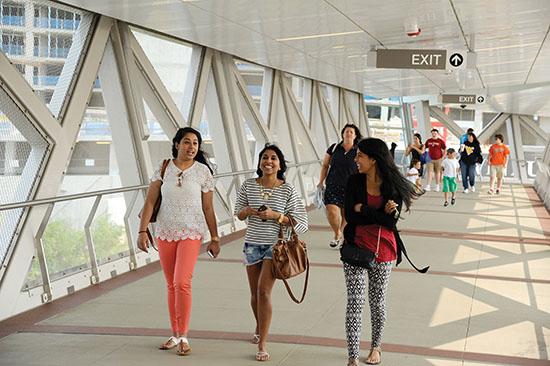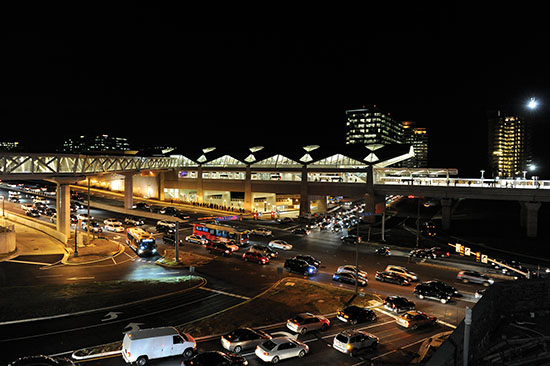
The Metro system in Northern Virginia includes the Blue line (opened since July 1977), the Yellow line (briefly running on Blue line tracks before traveling to and from the District), Orange line (opened in December 1979 after discussions about putting it either along I-66 or under Wilson Boulevard) and Silver line. The entire Metro system is the largest and most heavily used transit provider in the D.C. region, with 1.2 million commuters using it each day. It’s the second-busiest heavy rail system in the country behind New York.
Both the Blue line and Orange line have created significant economic prosperity around their stations—the Blue line at Pentagon and Crystal City and the Orange line in Rosslyn, Courthouse, Clarendon and Ballston.
In fact, property taxes on land around all Metrorail stations generates $3.1 billion annually in revenue, according to a report from WMATA. But those results were not guaranteed when the Metro was introduced to the area.

The choice of putting the Orange line under Wilson was “a stroke of genius,” according to Shyam Kannan, the managing director of the office of planning for WMATA. “I think it’s important to remember that the Wilson Boulevard traffic count is the same today as it was in the ’70s,” he says. “All the development in Clarendon for example along the Orange line has not increased traffic congestion, which is amazing.”
Developers of the I-66 corridor are keeping a plan for extending the Orange line further west from where it terminates in Vienna, but there is no commitment to doing that yet.
Kannan says that the core of the system is 26 stations (Rosslyn, Metro Center, Gallery Place, Pentagon and L’Enfant Plaza, among others) that are mostly in Arlington and the District. Any rail passenger who enters the system either goes through the core or gets off at the core. “Those stations have been at or above capacity since 2005,” Kannan says. “So in order to extend the facility more, we would need to have enough capacity to move the train cars as well as the passengers through the core of the system. And right now, that is unfunded. So we are aggressively seeking funding to make sure that we can fix it, if you will,” he says. “The Metro system is a circulatory system, and the heart has arteriosclerosis.”
The more recent WMATA news for Northern Virginians is the $5.7 billion development of the 23-mile, 11-stop Silver line, Metro’s newest line. The first of two stages of the Dulles Corridor Metrorail Project construction, from East Falls Church to Reston, was completed in mid-2014, with passenger service beginning July 26.
The Silver line has been pure gold to Tysons Corner, where the one of the line’s five new stops is in service. It has jump-started the process of making Tysons a true edge city. “I would say that it’s a little early for quantitative evidence, but we do have a lot of anecdotal evidence of how it’s contributed to the build out there,” Gerald Gordon, president and CEO of the Fairfax Economic Development Authority, says.
For example, he says, IntelSat, a world leader in satellite services, relocated its corporate headquarters from the District to Tysons Corner in an 188,000-square-foot, 20-story office building that is so close to the Silver line station “that you can walk out the front door and walk right into the station.
“Without the Silver line, they would not have even considered coming to Tysons,” Gordon says. “We had 100,000 jobs before the Silver line. Ultimately we will reach 320,000 jobs here. We will go from 12,000 residents to 120,000 residents. We are a city.” He says the area needs to have more houses at various levels of affordability for the workforce, and it needs more access and services that people demand—more pedestrian capabilities, more affordable and luxury housing, more services like a library and post office and medical emergency offices. “The skyline of Tysons Corner in five years will be entirely different than what it is today,” he says.

Kannan agrees. “There are projects in the pipeline or in the approval process that will add 20 million square feet of new office space, 2 million square feet of new retail space, which basically triples the retail footprint in Tysons. There are 18,000 new apartments and 10,000 new hotel rooms coming,” he says. “This is a city that is growing around a transit line.”
The second and, for now, final phase of Silver line construction is underway. It’s designed to have six stops on 11.4 miles from Reston through Dulles airport with the final stop, named Ashburn (Route 772), in Loudoun County.
Already, 200 pier supports for the aerial Silver line are going into place at Washington Dulles International Airport.
The completed phase two Silver line extension is expected to open in late 2018, according to Marcia McAllister, communications manager for the Dulles Corridor Metrorail Project.
She says that they expect to open all six stations at the same time, as was done for the first phase of the Silver line. The Silver line will travel down the median of the Dulles Toll Road then curl back around onto the median of the Dulles Greenway—the airport road from Dulles to Leesburg—on the way to the final stop at Ashburn.
“The original plan was for the station at Dulles Airport to be below ground,” McAllister says. “But it was decided to build an aerial station there to reduce costs and to keep toll fees down in Fairfax and Loudoun County because that is how this phase of the Silver line will be funded.”
Current plans call for the Dulles station to be built on the front of the existing north parking garage. Passengers will go down under the parking garage and use a moveable walkway to get to the terminal using a tunnel that already exists. “There were people who thought we should build the station adjacent to the terminal,” McAllister says. “And given the climate of today’s fears of terrorism and other incidents, you just don’t get approval to build that.”
When that line opens, the airport authority expects it to increase the number of passengers who fly in and out of Dulles, she says, finally allowing the airport to realize its potential. “Dulles is a major airport, but it has suffered somewhat in recent years because of political decisions that were made to move some of the long-distance carriers to Reagan National,” she says.
She says that the airport authority owns much of the land adjacent to the airport along the Loudoun County site, and that’s where more development will happen. “It will take decades,” she says. “It takes time for things to develop around airports and rail lines.” But some businesses are getting a jump on the development game in the area outside of the airport.
Even now, there is a lot of land scrambling and development going on along the planned stops of this part of the Silver line. Reston Town Center is building out, with talk of building one of the tallest buildings in Reston there—a 15-story, 179,000-square-foot building on the highest point of Reston, recently purchased and scheduled to be renovated as part of the mixed-use project called Reston Heights. “The market is hot,” McAllister says. “And Loudoun County has done some incredible rezoning around those sites, transforming those areas.”
More Metro work is being discussed, including tunnels between stops and additions to current rail lines.
Kannan says he would argue that the Northern Virginia area is actually undersupplied with respect to transit-oriented and transit-accessible places. “It’s just politically challenging to bring transit-accessible places about,” he says. “I would say that it’s not so much of a gamble to bring development to an area than a challenging engineering and funding exercise. But once we can get those pieces in alignment, we learn that it’s something that the market actually wants.”

(May 2015)
